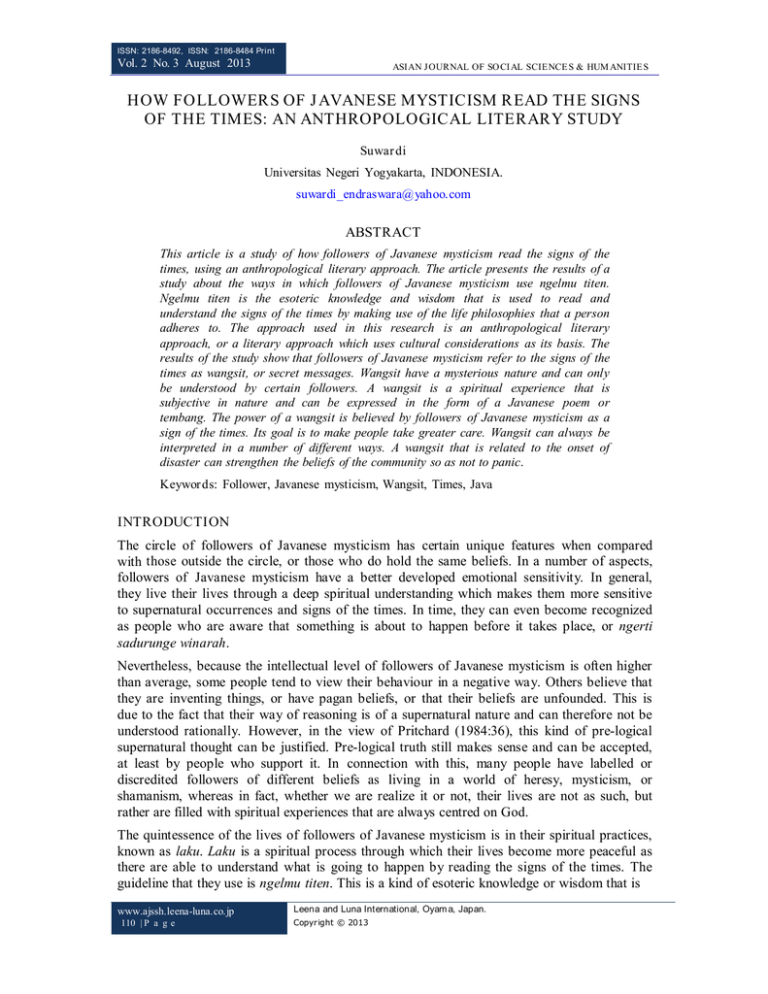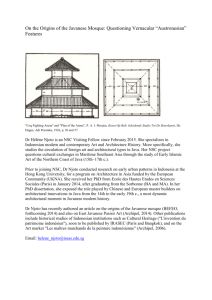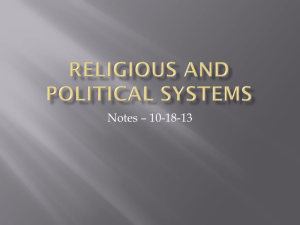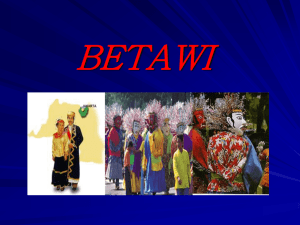HOW FOLLOWERS OF JAVANESE MYSTICISM READ THE SIGNS ABSTRACT
advertisement

ISSN: 2186-8492, ISSN: 2186-8484 Print Vol. 2 No. 3 August 2013 ASIAN JOURNAL OF SOCIAL SCIENCES & HUMANITIES HOW FOLLOWERS OF JAVANESE MYSTICISM READ THE SIGNS OF THE TIMES: AN ANTHROPOLOGICAL LITERARY STUDY Suwardi Universitas Negeri Yogyakarta, INDONESIA. suwardi_endraswara@yahoo.com ABSTRACT This article is a study of how followers of Javanese mysticism read the signs of the times, using an anthropological literary approach. The article presents the results of a study about the ways in which followers of Javanese mysticism use ngelmu titen. Ngelmu titen is the esoteric knowledge and wisdom that is used to read and understand the signs of the times by making use of the life philosophies that a person adheres to. The approach used in this research is an anthropological literary approach, or a literary approach which uses cultural considerations as its basis. The results of the study show that followers of Javanese mysticism refer to the signs of the times as wangsit, or secret messages. Wangsit have a mysterious nature and can only be understood by certain followers. A wangsit is a spiritual experience that is subjective in nature and can be expressed in the form of a Javanese poem or tembang. The power of a wangsit is believed by followers of Javanese mysticism as a sign of the times. Its goal is to make people take greater care. Wangsit can always be interpreted in a number of different ways. A wangsit that is related to the onset of disaster can strengthen the beliefs of the community so as not to panic. Keywords: Follower, Javanese mysticism, Wangsit, Times, Java INTRODUCTION The circle of followers of Javanese mysticism has certain unique features when compared with those outside the circle, or those who do hold the same beliefs. In a number of aspects, followers of Javanese mysticism have a better developed emotional sensitivity. In general, they live their lives through a deep spiritual understanding which makes them more sensitive to supernatural occurrences and signs of the times. In time, they can even become recognized as people who are aware that something is about to happen before it takes place, or ngerti sadurunge winarah. Nevertheless, because the intellectual level of followers of Javanese mysticism is often higher than average, some people tend to view their behaviour in a negative way. Others believe that they are inventing things, or have pagan beliefs, or that their beliefs are unfounded. This is due to the fact that their way of reasoning is of a supernatural nature and can therefore not be understood rationally. However, in the view of Pritchard (1984:36), this kind of pre-logical supernatural thought can be justified. Pre-logical truth still makes sense and can be accepted, at least by people who support it. In connection with this, many people have labelled or discredited followers of different beliefs as living in a world of heresy, mysticism, or shamanism, whereas in fact, whether we are realize it or not, their lives are not as such, but rather are filled with spiritual experiences that are always centred on God. The quintessence of the lives of followers of Javanese mysticism is in their spiritual practices, known as laku. Laku is a spiritual process through which their lives become more peaceful as there are able to understand what is going to happen by reading the signs of the times. The guideline that they use is ngelmu titen. This is a kind of esoteric knowledge or wisdom that is www.ajssh.leena-luna.co.jp 110 | P a g e Leena and Luna International, Oyam a, Japan. Copyright © 2013 ISSN: 2186-8492, ISSN: 2186-8484 Print Vol. 2 No. 3 August 2013 エシアン ゾロナル オフ ソシルサエニセズ アンドヒオメニテズ based on previous facts and memories, which are used in order to reflect upon subsequent events. However, people with this knowledge do not state their views openly or out loud. They take great care about revealing their spiritual knowledge to the outside world. For those followers of Javanese mysticism who has already reached a certain level, sensory perception or intuition is the main way in which they are able to read the signs of the times. They develop their senses and intuition so as to become more astute and sensitive to understanding various natural phenomena. They believe that everything that happens in this world is a divine revelation that needs to be recognized and understood. With a critical sense of understanding, followers of Javanese mysticism are able to avoid, beware of, ward off, and keep safe from dangerous occurrences. This is why; simply by using their spiritual awareness, they are always able to understand the world around them as a divine light. In relation to this, one of the characteristics of the lives of followers of Javanese mysticism is that they always use various oral traditions as a means of supernatural and cultural negotiation with the world roundabout them. These negotiations are often used to discredit Javanese people as cowards. Javanese people are afraid when they see other beings and feel they need to call for help. This may or may not be true and further studies are needed to determine the truth of this. Unequivocally, whether for reasons of safety or well-being, a partnership with another world or with other beings is in the beginning founded on fear. A highly religious partnership is thus, according to Beaty (2001:6), a variation of religious life. Although a belief is not a religion, its essence is still concerned with religious beliefs. These religious beliefs are in fact not as different from the practice of a particular religion as a variation of behaviour. RESEARCH METHODS This research uses an anthropological literary study. The idea for an anthropological literary study into the lives of followers of Javanese mysticism in reading the signs of the times combines a study of culture and literature from an anthropological point of view. This takes into consideration the fact that the lives of followers of Javanese mysticism are closely associated with works of oral literature in the form of poetry. These works need to be studied from a cultural and literary angle in order to discover the intricacies of human life. This is also emphasized by Benson (1993:13) in his book entitled Anthropology and Literature, in which he attempts to connect anthropology with literature in order to discover various aspects of human life from a cultural point of view. According to Ratna (2005:181-182), the anthropology of literature is an anthropological analysis presented through a work of literature, culture, and tradition. Followers of Javanese mysticism usually read the signs of the times through wangsit (secret messages). An anthropological literary study is a method that enables us to understand the cultural content of a work of literature from an anthropological point of view. This assumes that a work of literature offers numerous social and cultural features that have a deep meaning, and in this way we can discover how followers of Javanese mysticism read the signs of the times. This kind of interpretation is in fact in line with the characteristics of Javanese people who delight in oral cultures. It also recognizes the fact that Javanese mysticism stems largely from an oral culture. LIFE PHILOSOPHY AND SIGNS OF THE TIMES The life philosophy of followers of Javanese mysticism is the spiritual insight that affects their spiritual life. The ability to analyze or examine incidents that take place in fact stems (株) リ リ アンドル リ ル ル ル ル リ ル ル リル 小山市、日本. www. leena-luna.co.jp P a g e | 111 ISSN: 2186-8492, ISSN: 2186-8484 Print Vol. 2 No. 3 August 2013 ASIAN JOURNAL OF SOCIAL SCIENCES & HUMANITIES from the life philosophy that they adhere to. Hence, followers of Javanese mysticism can be said to have a special perception of life. In this case, the life philosophy that they adhere to is a system of norms for solving very basic problems. In order to understand the meaning of the life philosophies of followers of Javanese mysticism, which are concerned with mentality, religion, and spirituality, we need to orient our study to knowledge of the character and sense of Javanese mysticism, which is based on total integration or unity and is accommodative, tolerant, and unpretentious. This kind of existence presents a true portrait of the noble character of followers of Javanese mysticism. The subjectivity of true cultural and spiritual privacy that they adhere to is always kept in the depth of their hearts. In this sense, the lives of followers begin first with an eternal spirit, the rays of a divine substance which gives life to the human body that is born and lives in this mortal world until it leaves the body at a later time. Whether or not this eternal spirit can later return successfully to the origins of its eternity and become united once again with the divine substance depends upon its process in the world. This is the complete understanding of the knowledge and views of human life that are contained in the philosophy sangkan paraning dumadi dan manunggal/jumbuhing kawula gusti, or the origin and destination of creation and a divine union with God. This is the philosophy on which the lives of followers of Javanese mysticism is based and which enables them to read the signs of the times accurately. The caution that guards the wa y in which they witness events is founded on a deep metaphysical philosophy. The philosophy and material and spiritual cultural phenomena and the supernatural existence of Almight y God form human beings whose actions prioritize systems, norms, and values of a noble character and of love. In the knowledge of character and sense, which is known as spiritual philosophy or Javanese spiritualism, the main goal for reading the signs of the times is to attain a perfect physical, material, and spiritual life. Here we can understand that knowledge and its implementation must be by means of exoteric and esoteric behaviour, and be understood not only through logic or reason alone but also in greater depth through the acumen of the inner conscience (or the heart that has been illuminated by divine light), and based on an awareness of self eternity and spirituality (Nitihardjo, 1999:3). In this way, the lives of followers of Javanese mysticism are not simply centred on their thoughts but also on their feelings or inner conscience that they have developed. The mind or spirit is central to an understanding of life and of the times. An understanding of a particular time, through an understanding of the process and “origin” until success is achieved, is known as a perception of life or the philosophy of sangkan paraning dumadi, which is useful as a guideline to synchronize spiritual actions or lakulampah in order to obtain the efficiency of a “True Human Being”. This synchronization of laku-lampah is essentially the nurturing of a person’s knowledge in order to purify himself and restore the original substance that was present at the beginning of life that was given b y The Creator of All Life (God). It is God the Creator who gives guidance, including that of a supernatural nature, about the truth of all reason and the emotional essence of man, the wisdom of which can lead to a purity of an individual’s “spiritual identity” that will facilitate the return to his original place or the mystical beyond. With this kind of perception, the lives and movements of followers of Javanese mysticism are always founded on philosophy. Their life philosophies are the foundation of their understanding of all that happens in the universe. A self awareness and an awareness of a particular time is always founded on a knowledge and understanding of the essence of life, from and towards a divine goal. In this sense, God provides an aura which the follower then www.ajssh.leena-luna.co.jp 112 | P a g e Leena and Luna International, Oyam a, Japan. Copyright © 2013 ISSN: 2186-8492, ISSN: 2186-8484 Print Vol. 2 No. 3 August 2013 エシアン ゾロナル オフ ソシルサエニセズ アンドヒオメニテズ attempts to interpret. The acuity to interpret a particular time is an asset that will ultimately lead a follower back to God in a perfect condition. According to Negoro (2002:4-7), the main way to understand the signs of the times in Javanese mysticism is through meditation. This means that meditation is a way of sharpening the senses. It can even be said that meditation is the most important action, if we remember that our elders stated that all others acts apart from meditation are only a vehicle (dapur warana). A well-known practitioner of meditation from Yogyakarta states that the word samadi (meditation) comes from the words sam, which means large, and adi, which means beautiful; hence meditation is a means to attain something that is large, beautiful, pure, and perfect. Breathing exercises, meditation, and also Javanese mysticism used to be regarded as "gawat kaliwat-liwat" (dangerous practices), and were carried out only in secret and known only to a small number of people. The word samadi was disguised in the sentence "anggoleki tapake kuntul nglayang" – searching for the footprints of a flying crane – is it possible to find it; "anggoleki galihing kangkung" – searching for the heart of a bunch of water spinach – does it exist; "nutupi babahan hawa sanga" – covering the nine orifices of the body. These expressions are fine from a literary point of view, and were perhaps properly understood b y our ancestors, but in accordance with the developments that have taken place over the centuries, in which everything has changed, the understanding and practice of meditation is nowadays generally more open. The expressions above are often used as a means of spiritual training by followers of Javanese mysticism in an attempt to understand various phenomena or events roundabout them. With full concentration and by focusing on the meaning of these expressions, a follower will attain a special supernatural ability. The system for teaching Javanese mysticism is different from the system for teaching philosophy in ancient times, which took place openly in classes and was made available for anyone who was interested. The philosophy “Love of Wisdom” was carried out openly. Javanese mysticism, however, which is the “Love of Perfection”, based on a long and careful period of observation and experience can only be accepted by people who are speciall y chosen and who have the ability and strength to accept it and put it into practice. For this reason, it is taught only to a select number of people. This selection process is known as laku (spiritual practices or actions). Followers of Javanese mysticism perform these acts with clear proof. An understanding of Javanese mysticism can be viewed from a number of different aspects which will be explained in more depth below. One aspect of Javanese mysticism is its knowledge, or kawruh, known as kebatinan or Javanese spiritualism, which in turn can be divided into two further aspects, namely knowledge (ilmu) and wisdom, or esoteric knowledge (ngelmu). In a book about Javanese mysticism, entitled Membangun Hidup Mapan Lahir Batin, in the chapter entitled Menjelajah Jagat Gaib (Exploring the Supernatural World), there is an explanation about the difference between ilmu and ngelmu. Ilmu is described as the result of human thoughts and ideas which over time become more and more advanced due to new inventions and discoveries by experts in the field of science and technology; ngelmu on the other hand is related to the supernatural, and as such, it has always existed but is only discovered bit by bit in accordance with people’s needs. HOW FOLLOWERS OF JAVANESE MYSTICISM READ THE SIGNS OF THE TIMES The signs of the times are often beyond the power of the human mind. They contain a number of supernatural incidents which require a greater depth of understanding. However, for a (株) リ リ アンドル リ ル ル ル ル リ ル ル リル 小山市、日本. www. leena-luna.co.jp P a g e | 113 ISSN: 2186-8492, ISSN: 2186-8484 Print Vol. 2 No. 3 August 2013 ASIAN JOURNAL OF SOCIAL SCIENCES & HUMANITIES follower of Javanese mysticism who has highly developed senses, understanding the signs of the times is something that is ordinary and at the same time extraordinary. It is ordinary in the sense that it is practiced every day. In connection with this, it is not uncommon for a follower of Javanese mysticism to understand various kinds of incidents or events. The figure and characteristics of a Javanese leader, for example, is often understood by reading the signs of the times. For example, when followers of Javanese mysticism perform a certain ritual in the mountainous region of Sleman, specifically in the region of Mount Merapi, they will receive a supernatural sign (sasmita gaib). These signs come from the spirits of their ancestors, such as the great literary master, R. Ng. Ranggawarsita. These signs are then interpreted and obeyed in order to ensure a person’s safety and well-being. More importantly, Herucakra also states a number of practices that should be followed in order to ensure that his group of followers live in peace. By following these practices, it has been proven that many people have succeeded in various enterprises or ventures. They will even be safeguarded against any kind of disturbances, such as accidents. This messianic leader admits that the oral tradition of Herucakra is a movement with a nationalist philosophy, or the science of theosophy in the form of a religious culture. The foundation of this tradition in fact consists of elements of animism and dynamism in the context of cultural monotheism. The socialism of Herucakra will form a real nationalism. In Javanese, there is an expression: “sedumuk bathuk senyari bumi, kudu den rungkebi”, which means the width of a face is as wide as the palm of a hand, even the width of the earth that measures only the breadth of a finger will be defended. The traditional culture of Herucakra does not contradict either prophetic or non-prophetic religions. A supernatural sign will appear in the form of Klimah Mataram. Klimah Mataram are numerous, in particular those that were obtained by a true teacher by the name of EGA (Eyang Gusti Aji), and amongst other which read as follows: Kakang Semar lan Antogo kaki Ingsun weling ing sira kalihnya Kang dadya sesanggemane Ngirida gung lelembut Bala seluman nuswa Jawi Kabyantakna sang nata Herucakra prabu Nata tedhaking bathara Wijilira kang kathongga sonyaruri Sajroning alad Pudhak (Ega, 2010: Senin Paing, pukul 02.00) Translation: ‘Brothers Semar and Antogo I remind you both Of your duties in life There is an army of spirits on the Island of Java Join to help the king Prabu Herucakra, king descended of the gods www.ajssh.leena-luna.co.jp 114 | P a g e Leena and Luna International, Oyam a, Japan. Copyright © 2013 ISSN: 2186-8492, ISSN: 2186-8484 Print Vol. 2 No. 3 August 2013 エシアン ゾロナル オフ ソシルサエニセズ アンドヒオメニテズ Descendant of the king in the quiet world In the forest of Pudak’ This spiritual poem means that there is a supernatural utterance that wishes for the figures of Semar and Togog to herd together spirits. The spirits must be defeated in order to help the king, Herucakra. Herucakra is a king descended from the gods (a sublime man), who was born in a quiet, deserted place, in the forest of Pudak. This shows just how great are the hopes of followers of the oral tradition of Herucakra that they will soon have a real leader. It is also a reflection of their belief that the world of ghosts, the supernatural, and the mystical tradition can also be connected to political matters. In the tradition of followers of SBP 45, a group centred in Purworejo, there is a similar perception about national leadership. Through a close calculation of days, hours, and minutes, a person is able to guess what is going to happen. For example, at the time of the inauguration of the ministers in the United Cabinet of Indonesia, it was quite clear that it was not a favourable time. Therefore, it was difficult to deny the fact that over the next days and months, numerous strange events would take place, at the cost of a number of victims. This means that a particular moment in the life of a follower of Javanese mysticism strongly determines circumstances in the future. If this is the case, it means that the queen of justice will be determined by time according to Javanese calculations. If the numerological calculations are deemed accurate, it will ensure the safety and well-being of a particular group or an entire nation. Unfortunately, this type of numerological calculation is now becoming less frequently used. As a result, the nation is becoming increasingly worse off. Some scholars or academics even view the numerological calculations performed by followers of Javanese mysticism as “heresy,” a view which is unsubstantiated. This means that they are denying their ancestors, and the consequences will be even worse. A just leader is difficult to find if Javanese numerological calculations continue to be disregarded. EARTHQUAKES AND NATURAL PHENOMENA IN THE EYES OF FOLLOWERS OF JAVANESE MYSTICISM Believe it or not, the inner eyes of followers of Javanese mysticism are much sharper than those of ordinary people. On the day of the earthquake on 27 May 2006, shortly after dawn many followers had in fact already read the signs. Some followers in the Bantul area, for example, had already made their knowledge public but most people chose to ignore them. When a spiritualist from Parangtritis by the name of Suparno Budhiasih tried to convince people of the numerological calculations he had made, many did not believe him. However, what these followers feared did in fact happen, and that is a fact that cannot be denied. Prior to the event of the earthquake, some people were apparently able to see special signs. In the region of Wonokromo, for example, many earthworms came out from the soil. Some worms were even seen coming out from walls. This was not given much attention by the local inhabitants. However, several followers of Javanese mysticism gathered together to discuss the fact that this was a sign of nature. Similarly, when the sound “glung” is heard at the point of intersection between the Opak and Oya rivers, followers believe that an earthquake is sure to follow. This occurrence is also ignored by most ordinary people. But followers of Javanese mysticism take it seriously and as soon as possible hold a traditional ritual to ward off disaster. In this way, even if an earthquake does occur, there will not be too much damage. (株) リ リ アンドル リ ル ル ル ル リ ル ル リル 小山市、日本. www. leena-luna.co.jp P a g e | 115 ISSN: 2186-8492, ISSN: 2186-8484 Print Vol. 2 No. 3 August 2013 ASIAN JOURNAL OF SOCIAL SCIENCES & HUMANITIES A similar sign was received by Mardi Yuwono, an elderly follower of Sumarah Purbo from Wijirejo Pandak Bantul. Just before the earthquake in May 2006, he felt as though he had been awoken by his grandmother. He hurried outside. When he was woken up, of course he felt surprised. He could hardly believe that something was about to happen. But as he was pondering outside his house, suddenly the earthquake came. What he witnessed at that time was as though someone was climbing a coconut tree, fell down but then managed to climb up again. This incident could be interpreted as a feeling of thankfulness that safety would still come. According to the views of followers of Javanese mysticism, this kind of incident is a strong indication that we have forgotten about our ancestors. We have forgotten Kangjeng Ratu Kidul. This kind of mystical belief, according to Twikromo (2000:43) is quite valid as the influence of a kratonik culture. Therefore, it is highly likely that the people of Bantul and the surrounding area were alarmed by the issue of a tsunami. This is felt by almost all followers of Javanese mysticism as a kind of mystical negligence. Perhaps we are lacking in perception and forgetting to give thanks. As a result, we are inflicted by one event after another. Prior to the earthquake, did not Mount Merapi also erupt? Many people may scoff but in fact the earthquake came from the south, which is strange is it not? To followers of Javanese mysticism, it is not strange at all because a lesson may come at any given moment. The afternoon before the earthquake, many people saw cirrus clouds stretching from north to south. But few people recognized this as a sign of the times. Followers of Javanese mysticism, however, had already recognized the cirrus clouds as a sign from nature. Cirrus clouds are a reflection of an extraordinary “wrath of nature.” In the minds of followers, when they see such clouds, they prepare themselves, in their own way, to face any ordeals that ma y come. They meditate and perform rituals to ward off danger in order to protect their families. I was also quite shocked, when just several seconds after the earthquake, as people were hurrying out of their homes, I saw a large black circular object in the southwest, the size of the wheel of a truck. It looked like a circle of smoke from a cigarette; there for only a moment and then gone. I could only conclude that the earthquake was part of a life cycle that would disappear by itself. Earthquakes are difficult to ward off with anything other than strength and courage. The tragic incident of the earthquake described above was in fact predicted by Kangejng Pangeran Suryanegarain the Javanese poem Kinanthi, as follows: Wirayat kanthi dahuru lalakone zaman wuri, kang badhe jumeneng nata, amengku bawana jawi, kusuma trahing narendra, kang sinung panggalih suci. Ega, 2010: Selasa Kliwon, pukul 03.00) Translation: ‘History is filled with disasters The events of times past Will become king Rule the land of Java www.ajssh.leena-luna.co.jp 116 | P a g e Leena and Luna International, Oyam a, Japan. Copyright © 2013 ISSN: 2186-8492, ISSN: 2186-8484 Print Vol. 2 No. 3 August 2013 エシアン ゾロナル オフ ソシルサエニセズ アンドヒオメニテズ A knight descended from a king With a pure and noble heart’ This poem is in fact part of a prophecy about the fate of the times. Although it is not explicitly a reflection of the thoughts of followers of Javanese mysticism, in general they accept it as the truth. The world of mystical prophecies is one of the beliefs that cannot be separated from the world of Javanese mysticism. Implicitly, the poem contains the notion that an eminent knight or a queen of justice will appear in the land of Java after a disaster has occurred (in a situation of turmoil or chaos). This also means that after a disaster has occurred, joy will follow. After being afflicted by trouble, the lives of the Javanese people will be filled with happiness. A description of this terrible event appears in the following quote: Dene wontene dahuru, sasampune hardi Mrapi, gung kobar saking dahana, sigar tengahira kadi, lepen mili toya lahar, ngidul ngetan njog pasisir. Ega, 2010: Kamis Wage, pukul 02.00) Translation: ‘There will be disaster After Mount Merapi Burns even more strongly As though it is split down the middle Lava will flow like a river To the south, reaching as far as the coast’ Myang amblese glacap gunung, sarta ing Madura nagri, meh gathuk Ian Surabaya, sabibaripun tumuli, wiwit dahuru lon-lonan, saya lami saya ndadi. (Ega, 2010: Senin Wage, pukul 02.00) Translation: ‘And the mountain will be covered And the land of Madura Will almost become one with Surabaya Shortly after that Disaster will arrive, slowly Over time becoming greater’ I interpret these two poems as the brilliant thoughts and ideas of Javanese people in the past. Clearly, the poems describe the natural disaster that occurred when Mount Merapi erupted and its lava flowed into the South Sea. This was followed by the Lapindo disaster that over (株) リ リ アンドル リ ル ル ル ル リ ル ル リル 小山市、日本. www. leena-luna.co.jp P a g e | 117 ISSN: 2186-8492, ISSN: 2186-8484 Print Vol. 2 No. 3 August 2013 ASIAN JOURNAL OF SOCIAL SCIENCES & HUMANITIES time will gradually cause Surabaya and Madura to become joined together. The logic of this poem was proven when the Lapindo mud volcano disaster occurred. Despite the fact that it was originally caused by human error, in reality it has become a disaster that is difficult to stop. Natural phenomena are in fact closely connected with aspects of divine understanding. When a person’s depth of understanding and beliefs are weak, natural disasters will occur repeatedly. This is a kind of spiritual harmony that can appear in any place and at any time. In this kind of situation, only spiritual practices that are carried out with full concentration and will-power will be able to prevent such disasters taking place. Only the spiritual world that is understood and appreciated to the full, as a revelation from God, will be able to help. Other than that, all is in vain. CONCLUSION From the above analysis, it can be concluded that followers of Javanese mysticism do in fact have an acute ability to understand various phenomena or events. They develop and rely on their inner senses in order to observe events taking place around them. Nevertheless, followers of Javanese mysticism do not wish to relate the results of their spiritual detection openly to others who do not share similar beliefs. They only share their experiences with others who have a similar understanding. With such an understanding of the signs of the times, they are able to act with greater caution in order to guarantee their own safety and well-being. Moreover, since the results of their observation and recognition of incidents are also based on spiritual practices and the highly developed life philosophies of Javanese mysticism. They always place emphasis on developing their sensory perception in order to achieve a better understanding of divine revelations. Thus, they see such incidents as part of a life cycle that should be viewed with wisdom. Incident after incident occurs as a spiritual phenomenon. As a spiritual phenomenon, this of course needs to be responded to in a spiritual way. They always seek caution in order to ensure safety and well-being in various situations. This is why every activity of followers of Javanese mysticism that is of a mystical nature is complemented by an extra cautious attitude and behaviour. Their logic and reasoning is always based on a subjective empirical experience. For this reason, the spiritual experience of one follower and another is different, although in essence they are the same. www.ajssh.leena-luna.co.jp 118 | P a g e Leena and Luna International, Oyam a, Japan. Copyright © 2013 ISSN: 2186-8492, ISSN: 2186-8484 Print Vol. 2 No. 3 August 2013 エシアン ゾロナル オフ ソシルサエニセズ アンドヒオメニテズ REFRENCES Beatty, Andrew. 2001. Variasi Agama di Jawa; Suatu Pendekatan Antropologi. Jakarta: Murai dan Kencana. Benson, Paul. 1993. Anthropology and Literature. Chicago: University of Illinois Press. Endraswara, Suwardi. 2007. ”Penghayat Kepercayaan Memahami Dunia Hantu dan Gaib”, Jurnal Humanior, Juni. Yogyakarta: Lembaga Penelitian Yogyakarta. Negoro, Suryo, S. 2002. Kejawen menjawab Tantangan Jaman. Jakarta: Ritcom. Nitihardjo, Soeprapto. 1999. Sangkan Paraning Dumadi. Yogyakarta: Yayasan Sosrokartono. Pritchard, Evans, EE. 1984. Teori-teori tentang Agama Primitif. Jakarta: PLP2M. Ratna, Nyoman Kutha. 2005. Sastra dan Cultural Studies; Representasi Fiksi dan Fakta. Yogyakarta: Pustaka Pelajar. Triwikromo, Argo, Y. 2000. Ratu Kidul. Yogyakarta: Bentang. (株) リ リ アンドル リ ル ル ル ル リ ル ル リル 小山市、日本. www. leena-luna.co.jp P a g e | 119





